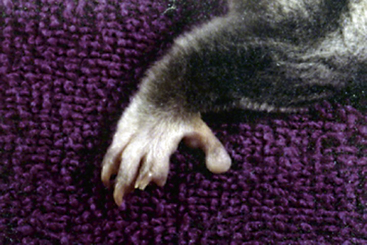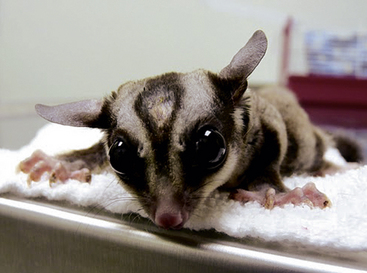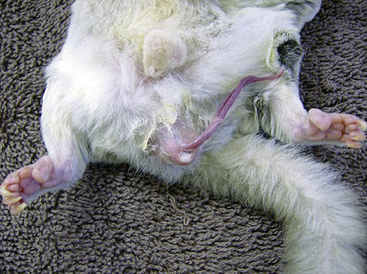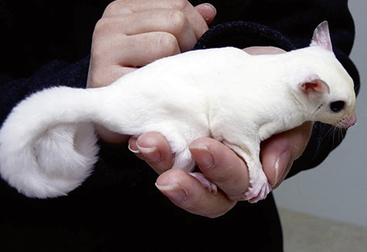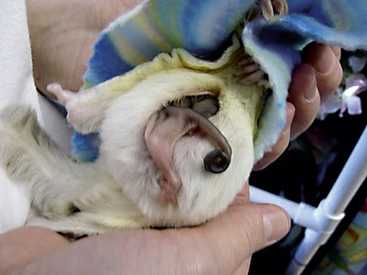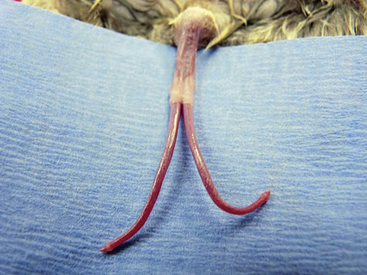Chapter 29 Sugar Gliders
Biology
Natural History
Sugar gliders (Petaurus breviceps) are small nocturnal arboreal marsupials native to New Guinea and the eastern coast of Australia.1,5,20 They inhabit open areas in tropical or coastal forests and dry inland sclerophyll tropical forests. They are social animals, with colonies of 6 to 10 animals occupying a territory of up to 1 hectare. Dominant males mark territory and other group members with scent gland secretions. Animals in a group nest communally in leaf-lined tree holes. During periods of extreme cold or food scarcity, sugar gliders conserve energy by going into torpor for as many as 16 hours per day.5
Anatomy And Physiology
Marsupials: General Information
The metabolism of marsupials is approximately two-thirds that of placental (eutherian) mammals. The normal heart rate of a sugar glider is 200 to 300 beats per minute; the respiratory rate is 16 to 40 breaths per minute.1 The cloaca is a common terminal opening of the rectum, urinary ducts, and genital ducts. Cloacal temperature is lower than the actual body temperature; the average cloacal temperature being 89.6°F (32°C).1,4,8,10 True rectal temperature in marsupials can be measured by directing the thermometer dorsally into the rectum from within the cloaca. The rectal temperature is usually 97.3°F (36.3°C).4 Measurement of the tympanic temperature is another means of determining core body temperature.
Anatomic Characteristics
Wild sugar gliders have soft, velvety fur that is gray, with a central black stripe dorsally; it is cream-colored ventrally. Like American flying squirrels (Glaucomys volaris, Glaucomys sabrinus), sugar gliders have a patagium (gliding membrane) that stretches between their front and hind legs (Fig. 29-1). There are at least seven recognized subspecies of sugar gliders. Although average body weight varies among the subspecies, typical adult males weigh between 100 and 160 g and females between 80 and 130 g. Body length ranges from 16 to 21 cm and tail length from 16.5 to 21 cm. Gliding distances are reported to be as long as 50 m.26 Being a nocturnal prey species, sugar gliders have large, protruding, widely spaced eyes. They have five toes on their hind feet, with an opposable first digit and syndactyly of the second and third digits (Fig. 29-2). Dominant males mark territory and group members with secretions from androgen-sensitive frontal (forehead) (Fig. 29-3), gular (throat) (Fig. 29-4), and paracloacal scent glands (Fig. 29-5).
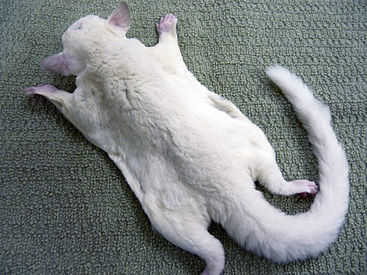
Fig. 29-1 The patagium, or gliding membrane, of sugar gliders stretches between the front and hind legs.
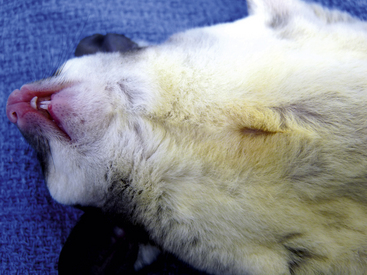
Fig. 29-4 The male glider also has a gular scent gland, located on the ventral aspect of the throat.
Color Variations and Genetics
Sugar gliders have become available in a variety of colors through selective genetic breeding in recent years. Although there has not been thorough genetic testing on these variations, some genetic trends have been realized by applying Mendel’s laws of heredity to well-documented breeding programs. Several color variations have been described and accepted as “standard” mutations. These variations of the natural gray line include the white face, white tip, leucistic, and mosaic. There is also a red-series classification that includes red cinnamon, lion, butter cream, and chocolate.
The leucistic sugar glider is all white with black eyes; therefore it is also referred to as black-eyed white (Fig. 29-6). Some leucistic gliders may have faint yellowish markings where the black would be on the standard gray coloration. The leucistic gene is recessive to the normal gray, following the principles of Mendelian genetics. The breeding of a heterozygous leucistic to a leucistic yields 50% leucistic and 50% heterozygous. Breeding two heterozygous leucistics can produce heterozygous, standard, or leucistic offspring in the expected ratios. This is a relatively rare and valuable coloration, whether the glider is white or just carrying the gene as a heterozygous leucisitc.
Reproduction
Sugar gliders are seasonally polyestrous, with the natural breeding season in Australia occurring between June and November. They are polygamous, with a dominant male that breeds with the mature females in the colony.5 Young (joeys) are typically born in the spring, when insects are plentiful. Litter size is usually two (81%) or, less commonly, one (19%).5 Two litters in a single breeding season are common. The estrous cycle is 29 days in length, and gestation is 15 to 17 days.1,14,15,27 Young weigh only 0.2 g at birth, when they migrate to the pouch. They remain in the pouch for 70 to 74 days (Fig. 29-7). After they outgrow the pouch, the young are left in the nest until they are weaned at 110 to 120 days of age. Table 29-1 lists the expected growth rate and specific developmental milestones as the joey ages.1,10 The young remain with the colony until they are forcibly dispersed, at 7 to 10 months of age.1,5 Sexual maturity is reached at 8 to 12 months of age in females and 12 to 15 months in males.1,14,15
The reproductive anatomy of sugar gliders is unique compared with that of other mammals routinely treated in practice. Female sugar gliders have two uteri and two long, thin, lateral vaginas that open into a single cul-de-sac divided by a septum. Both sexes have paracloacal glands, which are more developed in the male.25 Males have a large prostate with a constriction at the anterior third. They also have two pairs of Cowper’s glands in addition to three paracloacal glands. The testes are located in a prepenile pendulous scrotum, and the penis is bifid (Fig. 29-8). Males do not urinate from the forked end of the penis but rather from the proximal portion. Therefore the distal penis can be amputated in cases of penile trauma or paraphimosis.
Behavior
Sugar gliders are most responsive to and trusting of individuals they know, but they respond well if approached with patience and gentle handling. They enjoy cuddling and curling up in shirt pockets or pouches, where they feel safe. They should not be allowed to crawl into tight-fitting clothes, such as pants pockets, because of the risk of injury.
Advantages of these pets include their small size, playfulness, and intelligence. The life span of sugar gliders is longer than that of other comparably sized pets; they can live from 10 to 12 years in captivity.1 Disadvantages include their nocturnal nature, housing requirements, specific dietary needs, and musky odor.
Husbandry
Caging
Because of their active nature, sugar gliders should have cages as large as possible. These animals need space to climb, run, and jump. Minimum cage size is 36 × 24 × 36 in. (91 × 61 × 91 cm), but larger is better. Cages should be made of wire for good ventilation, with wire spacing no more than 1.0 × 0.5 in. (2.5 × 1.3 cm) wide. Sugar gliders tolerate temperatures between 65°F and 90°F (18°C and 32°C), with an ideal range of 75°F to 80°F (24°C-27°C).4,22 The cage must have designated areas for food, water, shelter, and exercise. Several food and water dishes should be placed in various locations throughout the cage. A nest box or sleeping pouch positioned high in the cage gives the sugar glider a place to sleep during the day. Branches, perches, and shelves can be placed at various levels of the cage to satisfy the natural behavior of climbing. Sugar gliders enjoy playing with bird toys, such as swings and chew toys. Plastic wheels without open rungs, such as a hamster wheel, are used for exercise. A variety of objects may be placed throughout the cage to stimulate and entertain these animals.
Sugar gliders need permanent access to a nest box for sleeping and hiding, with minimal daytime disturbances. Nest box size depends on colony size, but boxes should be at least 6 × 6 in. (15 × 15 cm) with a hinged lid and a circular opening on the front with a sliding closure.1,5,16,22 Bird nest boxes or small hollow logs are suitable. Nesting material can consist of hardwood shavings, recycled paper products, shredded bark, dried leaves, coconut fibers, sea grass, or equivalent materials. Artificial wool, cloth strips, and similar materials are not suitable because fibers have been known to entrap an animal’s limbs. Nest boxes must be cleaned and bedding material changed regularly, at least every 1 to 2 weeks. If nest box closures are secure, the nest box can be relocated from an outdoor aviary into the house for interaction each evening and then returned to the aviary to allow for nocturnal activity.
Nutrition and Feeding
Natural Diet
Sugar gliders are omnivorous. The diet of a wild sugar glider can include sap and gums (carbohydrate-rich) from eucalyptus and acacia trees, nectar and pollen, manna and honeydew, and a wide variety of insects and arachnids.5,13 Sugar gliders have specialized lower incisors for chewing and gouging into the bark of trees. The lengthened fourth digit on the manus aids in extracting insects from crevices. Sugar gliders also have an enlarged cecum, which functions principally in microbial fermentation of complex polysaccharides in gum.
Field energetics studies have demonstrated that wild sugar gliders consume 182 to 229 kilojoules (kJ)/day.19 This is equivalent to approximately 17% of body weight in wet weight of food.19 Captive gliders expend less energy in exercise and consume more easily assimilated foods than do those in the wild; therefore the total energy offered to gliders in captivity should be less.
Captive Diet
Captive diets must satisfy the numerous specializations of these insectivorous omnivores. The captive diet should include nectar, insects, and other protein sources as well as very limited amounts of fruits and vegetables.3,13,14 Portion size for one glider is roughly a tablespoon of insects or insectivore diet, a tablespoon of nectar, and one-half teaspoon of fruits, other types of insects, etc. The diet should be offered in fresh portions in the evening.
Approximately 50% of the diet should consist of sources of fruit sugars, preferably in the form of a sap or nectar. Sources include fresh nectar, maple syrup, honey, and artificial nectar products.3,13,14,22 Examples of commercial products include prepared lory diets and Gliderade (Avico, Fallbrook, CA). Gum Arabic (acacia) can be purchased as a powder, mixed into a thick paste, and used to simulate native gums: it can be used in holes in branches and on surfaces, with insects or bits of fruit stuck to it for enrichment and foraging.
Contrary to the nutritional needs observed in the wild, much of the information found in lay publications lists fruits and vegetables as a major portion of the captive diet. Fruit-based diets are harmful to captive sugar gliders because they provide inadequate protein and calcium and predispose animals to osteoporosis and periodontal disease.3,22 Although sugar gliders readily accept fruits, nuts, and grains, these are not a substantial part of their natural diet.
Leadbeater’s diet has been recommended as a base mixture for many sugar glider diets. This is an artificial nectar mix originally formulated for Leadbeater’s possums (Gymnobelideus leadbeateri).3,13,16 Leadbeater’s recipe consists of 150 mL water, 150 mL honey, 1 shelled hard-boiled egg, 25-g high-protein baby cereal, and 1 teaspoon vitamin and mineral powder. This mixture is kept refrigerated until served, with unused refrigerated portions discarded after 2 to 3 days. The mixture can be kept longer if frozen. The original Leadbeater’s recipe is often modified, with adjustments usually being made for palatability rather than nutritional content. Several modified versions are found on the Internet, such as Boubon’s Modified Leadbeater’s Diet and the High Protein Wombaroo Diet (Wombaroo, Adelaide, SA, Australia). These diets should be scrutinized closely, because none of them have undergone thorough nutritional dietary trials and analysis.
Several diets recommended by the authors are listed in Table 29-2. Choose one of these recipes and use it in its entirety. Chop the pieces together so that the gliders cannot pick out only their favorite items. No one commercial diet seems adequate, but long-term nutritional studies are still pending.3
Table 29-2 Suggested Sugar Glider Diets
